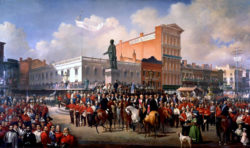Victor Pierson
Few details are known about the life of British-born hunting, landscape, and portrait painter Victor Pierson, who appears on the New Orleans city directories in the late nineteenth century.

Courtesy of Louisiana State Museum
Volunteer Firemen's Parade. Victor Pierson (artist), Paul E. Poincy (artist)
Information about the early life of painter Victor Pierson is scant. He arrived in New Orleans around 1865, probably by way of Mexico, and was active in the city until around 1873. He is believed to have been originally from England or France. While in New Orleans, he was known for his paintings of animals (particularly of horses), hunting scenes, and portraits. Typical of his work is the painting entitled French Cavalry Soldiers.
Pierson often worked with other artists in New Orleans to create large paintings. For example, he partnered with Theodore Sidney Moïse to produce a painting of the former horse racetrack in Metairie, Louisiana, On the Metairie (1867), which in 1868 was awarded a gold medal at the Grand State Fair for the best historical painting in oil. In 1871 he earned an award with John Genin at the Grand State Fair for best composition and best portrait. The following year he worked with Paul Poincy to produce Volunteer Firemen’s Parade, a monumental work depicting a procession as it was assembling on March 4, 1872, on Canal Street in New Orleans. The painting, more than 12 feet long, depicts firemen, horses, and spectators gathered around the statue of Henry Clay, a common rallying point. Lilienthal provided photographs of many of the firemen and recognizable civic figures who appeared in it, and Moïse promoted the support of fire companies that helped the artists complete the work. From 1872 to 1873 Pierson was listed as Poincy’s partner, and they exhibited in Uter’s store on Camp Street.
Pierson’s portrait of himself riding with Theodore Moïse in a coach pulled by two prancing white horses currently hangs in the Louisiana State Museum in Baton Rouge.
Little is known of Pierson’s later years. In 1873 he left New Orleans, probably to return to Mexico. The date of his death remains unknown.
